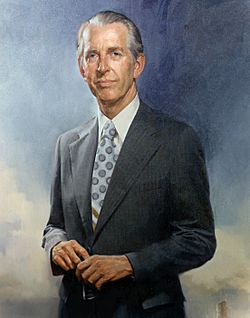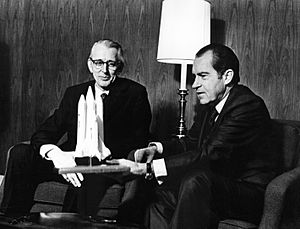James C. Fletcher facts for kids
Quick facts for kids
James C. Fletcher
|
|
|---|---|

Official NASA Portrait
|
|
| Born | June 5, 1919 |
| Died | December 22, 1991 (aged 72) |
| Resting place | Salt Lake City Cemetery |
| Alma mater | Columbia University California Institute of Technology |
| Scientific career | |
| Fields | Physics |
| Institutions | NASA University of Utah |
James Chipman Fletcher (born June 5, 1919 – died December 22, 1991) was a very important leader at NASA. He served as the head of NASA two times. His first time was from 1971 to 1977, when Richard Nixon was President. His second time was from 1986 to 1989, when Ronald Reagan was President.
During his time at NASA, he helped start the Space Shuttle program. Later, he led the effort to get the Space Shuttle flying again after the sad Challenger accident. Before working at NASA, he was the president of the University of Utah from 1964 to 1971.
Contents
Early Life and Education
James C. Fletcher was born in Millburn, New Jersey. His father, Harvey Fletcher, was famous for his work with sound. He is known as the "Father of Stereophonic sound".
James Fletcher studied physics. He earned his first degree from Columbia College. Later, he got his Ph.D. (a very high degree) in physics from the California Institute of Technology in 1948.
After finishing his studies, he worked as a researcher and teacher. He taught at famous universities like Harvard and Princeton. In 1948, he started working at Hughes Aircraft. He also worked at the Guided Missile Division of the Ramo-Wooldridge Corporation.
Leading NASA's Space Missions
In 1958, James Fletcher helped start a company called Space Electronics Corporation. This company later joined with another to become Space General Corporation. He then became a vice president at Aerojet General Corporation.
In 1964, he became the president of the University of Utah. He held this job until 1971. That's when President Richard Nixon chose him to lead NASA.
First Time as NASA Administrator

During his first time leading NASA, James Fletcher made many important decisions. He was in charge when the Space Shuttle program began. This program created reusable spacecraft.
He also oversaw the Viking program, which sent landers to Mars. These landers explored the Martian surface. He also approved the Skylab missions, which were early space stations. He gave the green light for the Voyager space probes. These probes explored the outer planets of our solar system. He also approved the Apollo-Soyuz Test Project, a joint mission with the Soviet Union.
Returning to NASA After the Challenger Accident
After leaving NASA in 1977, Fletcher worked as a consultant. He advised important leaders on space policy. He also taught at the University of Pittsburgh.
In 1986, President Ronald Reagan asked Fletcher to come back and lead NASA again. This was a very challenging time for the agency. The Space Shuttle Challenger accident had just happened.
Fletcher's main job was to help NASA recover. Shuttle flights stopped for two years. During this time, Fletcher made sure NASA focused on safety. He made big changes to how the program worked. He also improved the management system.
He oversaw a complete redesign of parts of the Space Shuttle. This included making the solid rocket boosters safer. He also added a way for astronauts to escape if needed. The Space Shuttle finally returned to flight on September 29, 1988. Fletcher also approved the Hubble Space Telescope program. He continued to lead NASA until April 1989.
Later Life and Legacy
James Fletcher passed away in December 1991. He died from lung cancer at his home near Washington, DC. He was buried in the Salt Lake City Cemetery. He was a member of The Church of Jesus Christ of Latter-day Saints.
James C. Fletcher played a key role in shaping NASA's history. He helped start major space programs and guided the agency through difficult times.
See also
 In Spanish: James C. Fletcher para niños
In Spanish: James C. Fletcher para niños


